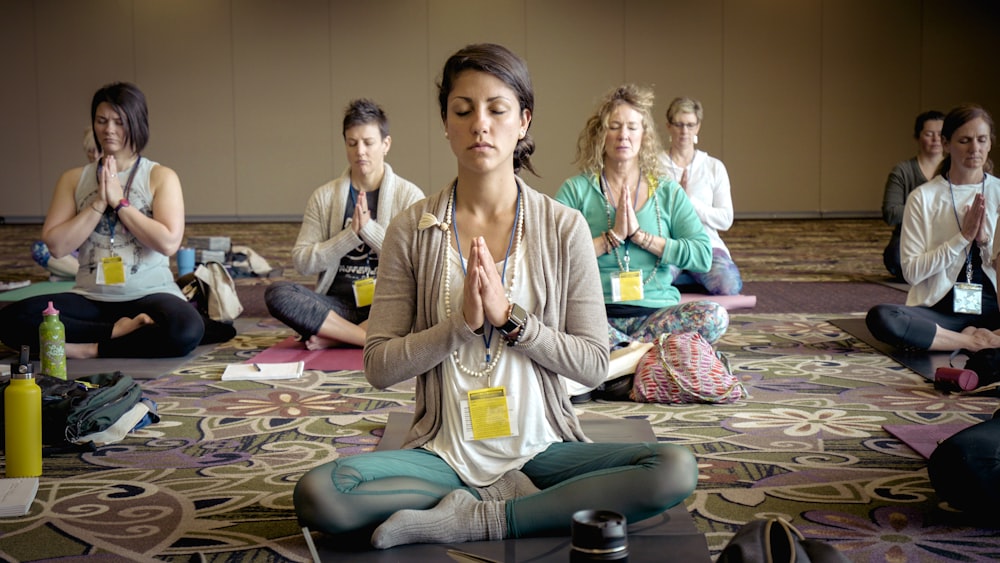
Many people swear by the benefits of cultivating mindfulness in their daily lives, and the most popular method is mindfulness meditation. This meditation technique is known to help people calm and regulate their nervous system, slow racing thoughts, and ground themselves.
Mindfulness meditation is a cognitive practice that emphasizes one’s ability to slow down intrusive or racing thoughts, let go of negative thought patterns, and calm the mind and body.
Mindfulness meditation involves concentrating and training your thoughts to be more positive while acknowledging thoughts and bodily sensations that flow through you. There are many health benefits of meditation, and mindfulness meditation is one of the most effective types of meditation.
It’s not always easy to get the hang of at first. However, regular practice of mindfulness meditation can play an indispensable role in improving your neurological and mental health, as well as your overall physical health. Once you know how to practice mindfulness meditation, you can integrate it into your everyday routine and enjoy the long-term health benefits.

What Exactly is Mindfulness?
The first step toward mastering mindfulness meditation is mastering mindfulness. Mindfulness is simply the practice of focusing on the present moment happening to you. If you are in a state of mindfulness, you are able to describe what you can see, hear and feel right now. Your mind does not wander. Instead, you are fully experiencing life.
Many define mindfulness as a state without distraction, evaluation or other thought processes. This does not mean you should adopt an “it is what it is” mentality all of the time, as there are many situations where you do need to judge what’s going on and act accordingly.
In everyday life, mindfulness helps us to enjoy positive situations, and perform better as we aren’t allowing our thoughts and emotions to distract us. With improved focus, you have better time management, and this in turn leads to stress relief as you aren’t scrambling to get things done at the last minute.
Practicing Mindfulness Meditation
First thing’s first: how do we start being mindful? It’s not necessarily about having a “quiet” mind: you can use any object or sensation as a focus for mindfulness meditation. Research on different mindfulness stimuli has found that different types of audio, a script, beat, melody and harmony, were all similarly effective. Maybe you are meditating at the beach, and choose to focus on the sound of the waves, the wind in your hair or the soft sand beneath you. If you’re at home and have a pet sitting on you, perhaps you would like to focus on the warmth of their fur.
Once you have chosen your focus, it’s also important to remember that mindfulness is not a competition or something that requires perfection. Don’t feel bad if you get distracted. Just acknowledge the distraction and return to focusing on your chosen mindfulness target.
Exercise 1: Mindful Breathing
Your breath is perhaps the simplest and most convenient mindfulness focus, enabling you to even practice it in bed. All you have to do is recognize your breath with “breathe in” and “breathe out”, or a similar phrase such as “this is an in-breath” or “I am breathing in”. This draws all of your attention to your breath, growing the habit of mindfulness as you are not preoccupied with other thoughts.
At this point in time, try not to judge how well you are breathing, for example, if your breaths feel short or uneven. You can develop a greater insight, such as every sensation tied to your breath or how it may change when you focus your attention.
Exercise 2: Add Concentration
This part is where you can continue focusing on your breath, or switch to another sensation or object near you. If you stick with your breath, you follow each inhalation from beginning to end, regardless of how long each breath is. The key is sustained attention.
Or, perhaps you’re sitting on the beach. If your focus is on the waves crashing, follow the sound of each ebb and flow from beginning to end. Alternatively, if you prefer an active type of meditation, such as incorporating mindfulness into a daily yoga or stretching sequence, follow each movement with your mind from beginning to end. Immerse your attention through each sensation, as you stretch your muscles just past your usual range of motion, and back again as you relax.

Exercise 3: Release Tension
Carrying tension in our bodies is a common habit, even when we are involved in gentle exercises such as walking or yoga. This is because our minds are commonly detached from our bodies and think of the future, past or another location instead of the present. Whether you are sitting still or in motion, take note of any tension you feel in your body. On breathing out, relax these areas, perhaps one at a time until you can no longer detect any tension. As many injuries from overuse or misuse (two-thirds of dance injuries are caused by overuse, for example), learning to connect with your body to notice and release tension can go a long way in maintaining your health and quality of life.
How Can Practicing Mindfulness Benefit Us?
Mindfulness helps you recognize destructive thought patterns before they take over. Mindfulness has also been found to reduce symptoms of depression and anxiety, as mindfulness teaches your brain to let intrusive thoughts go before they spiral out of control. Emotional mindfulness is when you’re aware of your triggers and why you’re feeling emotionally charged, and you’re able to stop emotionally charged thoughts from taking control.
Areas of the brain involved in emotional regulation function better with mindfulness practices, alongside others involved in maintaining attention. This means, over time, you may enjoy an improved attention span too. Other research shows better performance at work, reduced pain after medical procedures, and overall improved quality of life across a range of health statuses.
Even the structure of our brains improves with mindfulness meditation. Research has demonstrated improved grey matter density in the hippocampus, left inferior temporal lobe and other clusters after regular mindfulness intervention. In volunteers with age-related cognitive decline, there is slower ageing of regions such as the hippocampus. The effects of mindfulness meditation on mental health aren’t just about improving the rate of natural brain regeneration. While the anterior cingulate cortex (ACC) increases in grey matter, the amygdala shrinks. The ACC is essential for emotional and attention regulation, but the amygdala controls fear, anger and stress. This means that mindfulness may assist people with ADHD and even bipolar disorder, but more research is needed.
Mindfulness meditation is only one of the ways you can manage your stress and self-regulate your nervous system. To learn more about how to improve your stress management, consider taking a CircleDNA test to find out your genetic stress tolerance, your personality profile, and more.







Comments are closed.